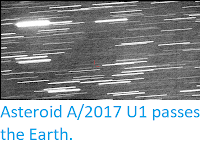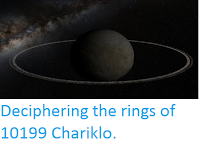Whilst astronomers have known for a long while that our Solar System was likely to contain objects of extra-Solar origin (i.e. from outside the system), but since the passage of interstellar object `Oumuamua (or 1I/2017 U1, or A/2017 U1) through the Inner Solar System in 2017, interest in the subject has grown. This has led to a search for other extra-Solar objects within the Solar System, with one more object, asteroid (514107) 2015 BZ509, having been suggested as to be a possible candidate object, on the basis of an orbit unlikely to have originated within the Solar System.
In a paper published on the arXiv database at Cornell University Library on 23 November 2018, and submitted for publication in the Monthly Nottices of the Royal Astronomical Society, Amir Siraj and Abraham Loeb of the Department of Astronomy, Harvard University, describe a method for looking for new extra-Solar objects within our Solar System, and suggest four more candidate objects.
Siraj and Loeb estimate that about twelve extra-Solar objects enter the Solar System each century, and that there are about 6000 such objects in the Solar System at any given time. In order to determine where to look for such objects they used a computer model of the Solar System to plot the course of simulated extra-Solar objects through the system, finding that 2.571% of such objects were captured due to gravitational interactions with the Sun and Jupiter.
These objects became captured in orbits with average distances from the Sun of between 0.49 AU (i.e. 49% of the distance of the distance at which the Earth orbits the Sun) and 2000 AU, with 25% of objects orbiting at an average distance of less than 6.9 AU, 50% at less than 13 AU, and 75% at less than 28 AU. Furthermore, the objects had aphelion distances (furthest points from the Sun on their orbits) of up to 4000 AU, with an average of 21 AU from the Sun, with 25% of objects having aphelions of less than 9.6 AU and 75% at distances of less than 50 AU. The objects had an average perihelion (closest point on their orbit to the Sun) of 4.0 AU, with 25% having perihelions of less than 2.6 AU and 75% having a perihelion of less than 4.9 AU.
The objects had an avarage orbital eccentricity of 0.74 (where 0.00 is a circular orbit and 1.00 is a straight line), with 50% of objects having an eccentricity of between 0.54 and 0.89. The objects had an average inclination to the plain of the Solar System of 33 °, and 50% of objects orbiting at inclinations of between 24 ° and 47 °, and a maximum inclination of 160°. Finally these objects had an average orbital period of 42 years, with 25% of objects having orbital periods of less than 17 years and 75% of objects having orbital periods of less than 140 years.
In order to look for candidate extra-Solar objects, Siraj and Loeb concentrated on the Centaurs, a population of Solar System bodies on paths that cross the orbits of
the major planets of the Outer Solar System (a body is defined as a
Centaur if its orbit brings it no closer to the Sun than the planet
Jupiter, but its average distance from the Sun is less than that of
Neptune). They searched previously published records for Centaurs with average distances from the Sun of between 6.9 AU and 28 AU, and eccentricities of between 0.54 and 0.89, and concentrated on objects with inclinations to the Solar plain of greater than 77° (the majority of extra-Solar objects are predicted to have inclinations lower than this, however the majority of non-extra-Solar objects also have lower inclinations, and objects with such high inclinations are thought to be more likely to have an extra-Solar origin, since the the majority of Centaurs are thought to have a common origin, having been pulled inwards from the Scattered Disk by the gravitational pull of the planet Neptune, and it is very difficult for such objects to reach highly inclined orbital paths).
They found four objects that matched these criteria, 2018 TL6, which has an orbit that takes it from 1.72 to 14.8 AU from the Sun, with an average of 8.26, an inclination of 170.9° (or an inclination of 9.1° and a retrograde orbit, an orbit in the opposite direction to almost everything else in the Solar System), and an eccentricity of 0.79, 2017 SV13, which has an orbit that takes it from 2.01 to 17.3 AU from the Sun, with an average of 9.65, an inclination of 113.2°, and an eccentricity of 0.79, 2011 SP75, which has an orbit that takes it from 2.27 to 36.8 AU from the Sun, with an average of 19.54, an inclination of 109.1°, and an eccentricity of 0.88, and 2017 RR2, which has an orbit that takes it from 2.63 to 44.7 AU from the Sun, with an average of 23.65, an inclination of 89.1°, and an eccentricity of 0.89.
The orbit and current position of asteroid 2018 TL6, a Centaur and potential extra-Solar object. JPL Small Body Database Browser.
Siraj and Loeb further note that the previously nominated candidate extra-Solar object, (514107) 2015 BZ509, falls within the possible candidate extra-Solar object range established by their model, but does not fall within the most likely part of the distribution range, having an average distance from the Sun and an average eccentricity lower than 75% of the simulated objects (though they do note that these parameters would do make it much easier to spot, and therefore what might be expected of one of the first such objects detected).
See also...
The orbit and current position of asteroid 2017 RR2, a Centaur and potential extra-Solar object. JPL Small Body Database.
See also...
Follow Sciency Thoughts on Facebook.








